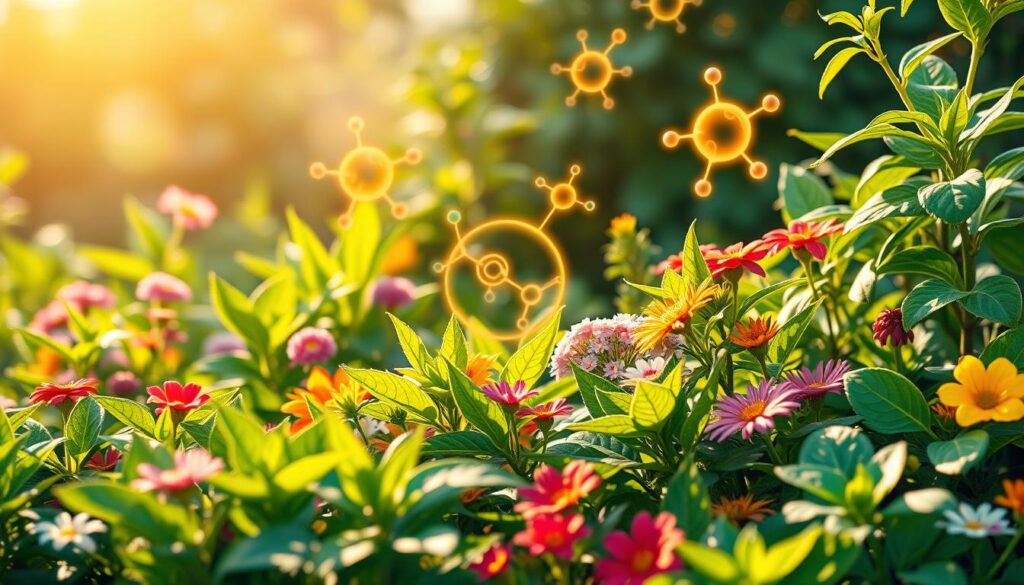Anúncios
To make your plants grow strong, you need to know a few key things. This guide will cover important gardening tips. These include how to give your plants the right nutrients, keep the soil healthy, and understand the best environment for them. By taking good care of your plants at every stage, they will become more lively and tough.

Seek App
Understanding the Role of Nutrients in Plant Growth
Nutrients are key to plant growth at every stage. Knowing which nutrients plants need and ensuring they’re available is crucial for health. This section covers the important macro and micronutrients needed for strong growth.
Anúncios
The Essential Nutrients for Plant Development
Plants need a mix of macro and micronutrients to flourish. Macronutrients like nitrogen, phosphorus, and potassium support major growth stages and processes. Micronutrients, even in small amounts, like iron and magnesium, play big roles in plants’ health and function.
- Nitrogen: Crucial for leaf growth and green color.
- Phosphorus: Supports root development and flowering.
- Potassium: Regulates water use and helps resist disease.
- Iron: Vital for chlorophyll production.
- Magnesium: A key component of photosynthesis.
How Nutrient Deficiency Affects Growth
If plants don’t get enough nutrients, it can slow their growth. Stunted growth and yellow leaves are often the first warning signs. Lack of nutrients can also mean poor fruiting. These are clues that the plant needs more nutrients.
Anúncios
Gardeners should check their plants and soil regularly to spot problems. Fixing these issues quickly is key to keeping plants healthy and getting a good harvest.

Stages of Plant Growth: A Detailed Overview
Plant growth happens in different stages, each bringing something special to the plant’s life. We’ll explore germination, vegetative growth, flowering, and ripening. Knowing about these stages helps us take better care of plants and get the best harvests. As plants grow, their needs change, so giving them the right nutrients at each stage is key.
Seed Germination and Sprouting
Germination is the first step for plants. This is when seeds wake up and start to grow, thanks to the nutrients they stored. They need just the right amount of water and warmth to begin. The seed absorbs water, swells up, and cracks open. This phase is critical as the plant starts to develop its roots and shoots.
Vegetative Stage: Fostering Robust Growth
After germination comes the vegetative stage. This is a time of fast growth. Now, the plant works hard to grow strong leaves. Nitrogen is super important during this stage. It helps leaves grow well, which helps with photosynthesis and energy.
Transition to Flowering and Ripening
Next, the plant starts to flower and get ready to make fruits or seeds. At this point, it needs different nutrients like phosphorus and potassium. These are vital for getting good flowers and fruits. After the flowering, the plant ripens its fruits or seeds. This is how it makes sure there will be more plants in the future.
The Importance of Soil Health for Optimized Growth
Keeping the soil healthy is key for plants to grow well and produce more. A strong soil is made of sand, silt, clay, and organic stuff. Together, they help plants grow strong and get the nutrients they need. Good soil lets roots get water and food easily. By knowing how to manage soil, we can make our plants flourish.
Understanding Soil Composition and Structure
The mix of sand, silt, clay, and organic bits in the soil is important. This mix helps the soil hold water, drain well, and let air through, which plants need to grow. A good mix lets roots spread out, helps water soak in, and keeps nutrients in the soil. Organic matter makes nutrients more available and helps good microbes live in the soil, helping plants thrive.
Soil Testing: Why It Matters
Testing the soil is a great way to know what it needs to be healthier. It shows what nutrients are missing and the soil’s pH level. With this info, gardeners can choose the best way to add what the soil lacks. By picking the right changes, plants can get all they need to grow better and be healthier, which means more produce.
Utilizing Fertilization Techniques for Healthy Plants
Effective fertilization methods are key for strong, healthy plants. Knowing the difference between organic and chemical fertilizers helps gardeners make the best choices. Each type offers benefits and challenges, fitting different garden styles and eco-friendly efforts.
Organic vs. Chemical Fertilizers: A Comparison
Organic fertilizers improve soil health over time, coming from natural sources like compost and bone meal. They add good microorganisms and better the soil’s structure. This means the soil holds water more efficiently and nutrients move better.
Chemical fertilizers give plants a quick nutrient boost, leading to fast growth. However, these synthetic options can harm soil balance if not used right. Over time, too much chemical fertilizer can hurt the soil and reduce its life.
Customizing Fertilizer Application: Timing and Method
It’s critical to tailor when and how you fertilize plants for the best nutrient take-up and growth. Applying fertilizer at the right growth stage helps plants get what they need. For example, they might need more nitrogen when they’re growing leaves.
Choosing how to apply fertilizer, like mixing it into the soil or spraying it on leaves, matters too. Each plant has its own needs. Keeping an eye on plant growth and soil condition helps adjust your fertilizing approach. This ensures your garden stays healthy and thriving.
Watering Practices: Strike the Right Balance
Effective watering is key to keeping plants healthy. Knowing how much water plants need helps them grow well. Each plant has its own water needs, depending on what kind it is, how big it is, and the weather. It’s important to avoid giving them too much or too little water. Doing it wrong can make plants weak and slow down their growth.
How Much Water Do Plants Need?
To figure out the right amount of water for your plants, look at a few things:
- Soil Type: Sandy soils lose water fast and may need watering more often than clay soils.
- Plant Type: Some plants, like succulents, need less water, while tropical plants may need more.
- Climate: In hot weather, water evaporates quicker, so plants might need more water.
- Growth Stage: Young plants and seedlings usually need to stay moist more than older plants.
Techniques for Efficient Watering
There are smart ways to water plants that also save water:
- Drip Irrigation: This method gets water right to the roots, reducing waste.
- Soaker Hoses: These hoses let water soak into the ground slowly, keeping soil moist.
- Rainwater Harvesting: Using collected rainwater saves tap water and is better for plants because it doesn’t have chlorine.
Choosing the right way to water plants helps them grow strong roots and stay healthy. Watering plants correctly helps them thrive and grow tough, even in tough conditions.
Pest and Disease Management Strategies
Keeping your plants healthy and growing strong requires effective pest management. It’s vital to know common pests and signs of disease. This knowledge allows you to fight off pests like aphids and spider mites quickly.
Identifying Common Plant Pests
Learning about common threats to your plants is your first move. Not handling these pests right can harm your plants a lot. Look out for aphids, spider mites, whiteflies, and signs of fungal infections.
- Aphids: Small, sap-sucking insects that can weaken plants and cause leaf curl.
- Spider mites: Tiny arachnids that create webbing on plants and lead to leaf discoloration.
- Whiteflies: Small, winged insects that feed on the undersides of leaves, causing yellowing and stunted growth.
- Fungal infections: Often manifest as spots or mold on foliage, indicating issues that need addressing for plant health.
Organic Pest Control Methods
Choosing organic methods helps the environment and your plants. These approaches focus on sustainability and effectively control pests. Examples include using beneficial insects, natural sprays, and companion planting to keep pests away.
- Introducing beneficial insects like ladybugs and lacewings to naturally reduce pest populations.
- Using environmentally friendly sprays made from natural ingredients to deter pests without harming beneficial organisms.
- Practicing companion planting to enhance plant resilience and deter harmful insects.
Weed Control: A Necessary Aspect of Plant Care
Healthy plants need effective weed control. Weeds take water, light, and food from your plants. You must stop weeds early to help your garden flourish. Using the right techniques can reduce weeds and make your garden better.
Preventing Weed Growth: Best Practices
To stop weeds before they start, gardeners can use several methods:
- Mulching: Applying mulch blocks light from weeds and keeps soil moist.
- Proper Spacing: Plants spaced well get more air and fight weeds better.
- Maintaining Healthy Soil: Good soil helps plants grow strong and beat weeds.
Effective Weed Management Techniques
When prevention isn’t enough, you need effective ways to manage weeds:
- Hand-Pulling: For small problems, pulling weeds by hand is easy and green.
- Hoeing: Regular hoeing disrupts the soil and removes young weeds.
- Using Organic Herbicides: Organic herbicides attack tough weeds but protect the environment.
Temperature and Light Requirements for Optimal Growth
Knowing how light and temperature affect plants is key to their growth. Plants do well when they get the right amount of sunlight and warmth. Sunlight is important for making food through photosynthesis, which helps plants grow and stay healthy.
Understanding Light Intensity and Duration
Plants need different amounts of light, depending on the type. Light intensity and how long they’re exposed are important. Too little light makes plants weak. Too much can harm them. Here are important points:
- Assessing sunlight exposure: Knowing how much light your plants receive daily helps in adjusting their positioning.
- Using grow lights: Artificial lighting can supplement natural light, especially during shorter days.
- Monitoring light quality: The spectrum of light can affect growth patterns, with red and blue wavelengths being particularly beneficial.
The Impact of Temperature on Plant Health
Temperature is also crucial for plant health. Each plant has a preferred temperature range. Being too hot or cold can stop them from flowering or making fruits. Here’s what to consider:
- Identifying ideal temperature ranges: Understanding the specific requirements for your plants can prevent overheating or chilling.
- Implementing temperature control measures: Use heaters in colder months and shade cloths or fans in warmer seasons to maintain a stable environment.
- Recognizing signs of stress: Watch for changes in leaf color or wilting, which can indicate that temperature levels may not be suitable for healthy growth.
Plant Health: Monitoring and Maintenance Techniques
To keep plants healthy, you need to check on them often and use good care methods. Watching your plants closely helps spot problems early. This way, you can take care of your plants before issues get worse.
Regular Health Checks: Importance and Frequency
Regular health checks let gardeners know how their plants are doing. How often you check depends on the plant type and where it grows. When checking, look at the plant’s leaves, see if it’s wilting, and check for spots or odd colors.
- Assessing foliage color and texture
- Observing for any signs of wilting or drooping
- Checking for unusual spots or discoloration
- Monitoring growth patterns and development
Signs of Stress in Plants
Knowing when plants are stressed is key to fixing problems fast. Some signs are yellow leaves, slow growth, bugs, or fungus. If the tips of leaves turn brown, that’s also a sign.
- Yellowing leaves or leaf drop
- Stunted growth or lack of new shoots
- Pest infestations or fungal growth
- Browning leaf edges or tips
Using the right care methods quickly when you see these signs can make your plants healthy again. Good monitoring and acting fast are important for keeping plants strong and looking great.
Creating a Sustainable Plant Care Routine
Making a plant care routine that’s good for the earth matches the needs of many plants. It changes with the seasons to give plants the best care all year. This keeps plants healthy and strong.
Seasonal Care Practices for Different Plant Types
Plants need different care in each season. Here are key care tips for them to thrive:
- In spring, focus on planting and fertilizing to encourage robust growth.
- During summer, ensure regular watering and mulching to retain moisture.
- In fall, perform pruning and prepare plants for winter by applying protective layers.
- Winter care may include indoor relocation for sensitive species or applying compost to enrich soil in prelude to spring growth.
Integrating Sustainable Practices into Plant Care
Adding green practices to your gardening can make plant care even better. Think about these ideas:
- Utilizing compost to enrich soil and reduce waste.
- Implementing crop rotation to maintain soil health and nutrient levels.
- Conserving water through rainwater harvesting and efficient irrigation methods.
- Employing natural pest control methods to reduce chemical usage and promote biodiversity.
The Benefits of Companion Planting for Healthier Growth
Companion planting is an age-old method. It uses natural relationships between plants for healthier growth. Gardeners can boost nutrient absorption and create a richer ecosystem in their gardens through this technique.
This approach not only betters plant health but also boosts biodiversity. It lets different species grow together effortlessly.
How Companion Planting Supports Nutrient Uptake
Pairing plants strategically is key to better nutrient uptake. Some plants make soil nutrients more available to their neighbors. For example, legumes, like beans, add nitrogen to the soil. This helps nearby plants grow better.
This cooperation makes it easier for plants to get the nutrients they need. It leads to a healthier, more fruitful garden.
Creating Biodiverse Garden Spaces
Companion planting encourages biodiversity, vital for a strong ecosystem. A mix of plants draws in good insects and keeps bad pests away. It also boosts soil health by supporting various microorganisms.
Choosing the right companion plants helps create a garden that benefits different species. It also makes gardening more rewarding.
Conclusion
Getting the best plant health means knowing a lot about gardening. This includes nutrients, soil health, and how to water right. The article shows why it’s key to keep an eye on these things. This way, plants get the right nutrients and grow in the best places. Each part is crucial to making sure your garden does well, giving gardeners hints on how to make a great ecosystem.
To help plants reach their best, gardeners can use pest management, fight weeds, and try companion planting. These steps help plants grow well and make gardening more eco-friendly. Using these tips often means your plants will be healthier and your garden more lively.
Using the tips from this article will help you become a pro at gardening. Just a bit of knowledge and care can change your gardening game. It makes sure your plants stay healthy for a long time.



